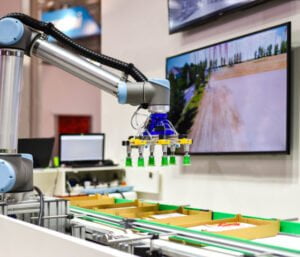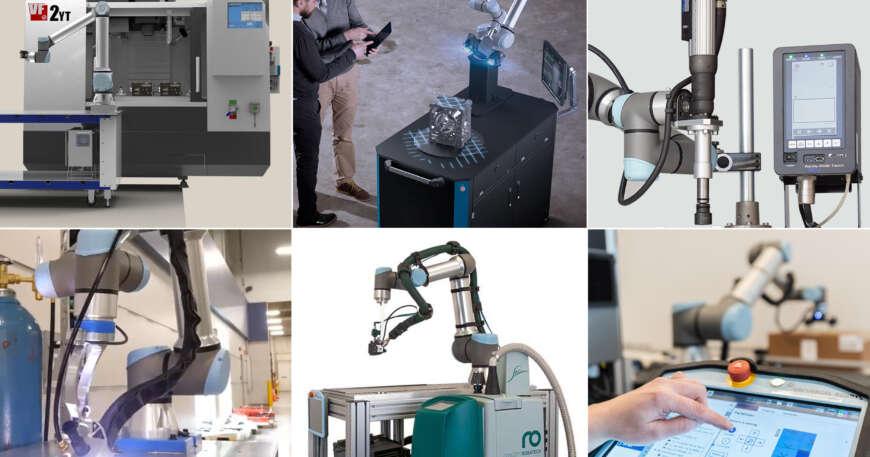The industrial arena is undergoing a profound shift propelled by the advancing sophistication and acceptance of collaborative robots. These versatile machines, crafted to operate alongside humans, are transcending traditional automation, evolving into intelligent partners that elevate safety, efficiency, and eco-friendliness.

Advancements in Safety: Ensuring a Secure Work Environment:
Innovative Sensor Fusion Technology:
Employing a fusion of LiDAR, ultrasonic, and pressure sensors, collaborative robots meticulously map their surroundings with exceptional accuracy. This enables them to adapt dynamically to their environment, sidestepping collisions with humans or impediments. At Ford’s Herne Bosch engine plant, Universal Robots‘ UR10e collaborative robots leverage sensor fusion technology to maneuver seamlessly through bustling workspaces, safeguarding worker well-being and maintaining uninterrupted production.
Virtual Safety Zones:
Picture invisible barriers shielding workers from harm. Through the establishment of virtual zones via cameras and sensors, designated areas are marked as safe for human presence. Collaborative robots respond instantly, slowing down or pausing operations upon detecting a worker’s entry into a zone, thereby averting potential injuries. Spearheaded by industry leaders such as ABB, this innovation fosters harmonious collaboration while upholding paramount safety standards.
Intuitive Interfaces and Communication:
Abandon intricate programming methods. Collaborative robots have embraced intuitive interfaces such as touchscreens, voice commands, and gesture recognition. These accessible interfaces cultivate trust and enhance situational awareness, paving the way for deeper human-robot cooperation. Take Stäubli’s CS8 collaborative robots, for instance, which assist workers in task execution through projected displays, further simplifying interactions.
AI Integration:
Built to streamline technical requirements compared to their predecessors, cobot robots are now further simplified and expedited through the integration of AI. By harnessing AI capabilities, these robots can effortlessly onboard, integrate, and become productive. Utilizing AI, collaborative robots have the ability to identify new objects by observing human behavior or leveraging virtual reality, eliminating the need for a repository of training imagery.
Proactive Maintenance and Self-Diagnostic Capabilities :
AI-driven collaborative robots possess the capability to autonomously monitor their own well-being, forecast potential malfunctions, and initiate maintenance requests as needed. This proactive strategy, exemplified by KUKA’s LBR iiwi cobot robot, mitigates disruptions and preserves operational efficiency, ensuring seamless functioning of production lines.
Advanced Human-Robot Interaction:
AI empowers collaborative robots to comprehend spoken instructions and communicate using natural language, promoting intuitive collaboration.
Virtual Reality (VR) for Training and Simulation:
Virtual Reality (VR) is revolutionizing factory automation, particularly in two key areas. Firstly, VR is instrumental in robot programming and simulation. Engineers and operators can meticulously program and simulate robotic tasks within a virtual environment before actual implementation in the real world.
This pre-emptive approach not only ensures safer and more efficient setup processes but also significantly reduces the time and costs associated with deploying cobot robot on the factory floor.
Secondly, VR serves as a pivotal tool for training and skill development. By offering a deeply immersive environment, VR allows workers to familiarize themselves with collaborative robots’ operations without the inherent risks of physical training. This immersive training method proves invaluable, especially for mastering complex tasks, as it empowers workers to cultivate confidence and proficiency within a controlled virtual setting.
Cutting-edge Gripping Mechanisms and Manipulation Techniques:
Cutting-edge grippers and manipulation technology empower cobot robot to delicately handle intricate components, maneuver diverse objects, and accommodate unforeseen shapes and sizes.
Augmented by sensors and AI, these robots can dynamically adjust grip strength, enabling seamless manipulation of objects with varying characteristics. This versatility significantly enhances the adaptability of collaborative robots across a wide range of manufacturing settings.

Promoting Sustainability through Environmental Solutions:
Collaborative robots aren’t just enhancing productivity—they’re also instrumental in shaping a more sustainable future. With advanced vision systems and AI capabilities, they undertake vital tasks such as cleaning solar panels and inspecting wind turbines, minimizing human exposure to hazardous work environments. Additionally, these robots efficiently categorize waste, contributing to reduced landfill usage and increased recycling rates.
In the realm of manufacturing, RUPES, an Italian power tool manufacturer, has integrated Universal Robots into its production line, revolutionizing the industry. This collaboration has led to substantial improvements, including minimized waste and operational costs, enhanced working conditions, and the ability for human workers to focus on higher-value tasks. This optimization has not only streamlined manufacturing processes but also significantly boosted productivity.
The Future of Collaborative Robots:
As collaborative robots undergo continual evolution, their influence on various industries will undoubtedly expand. With ongoing advancements in AI, safety protocols, and human-robot interfaces, these robots are poised to become indispensable allies, reshaping our approach to work and interactions with machinery.
MARKROBOTIC LTD COMPANY Has more than 14 years of experience and is well known for high-performance IML ROBOT ,EOAT System , TOP ENTRY ROBOT , Handle Fitting Machines, cobot robot , Medical Automation Systems as well as innovative downstream solutions that include Product/Decoration Inspection, Assembly-and Box Filling Systems.
Headquarter of MARKROBOTIC is based in Istanbul /Turkey , providing superior service and greater overall value to a rapidly expanding global customer base.
cobot robot





